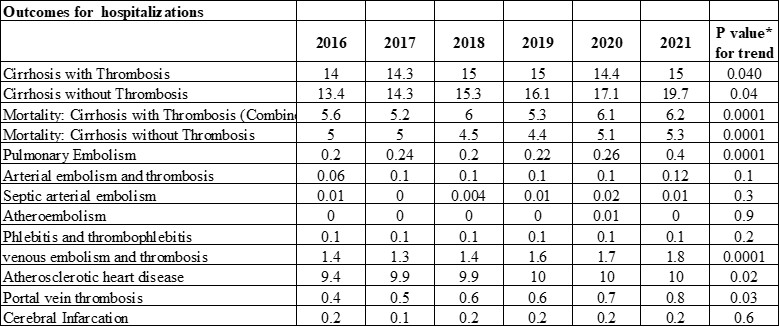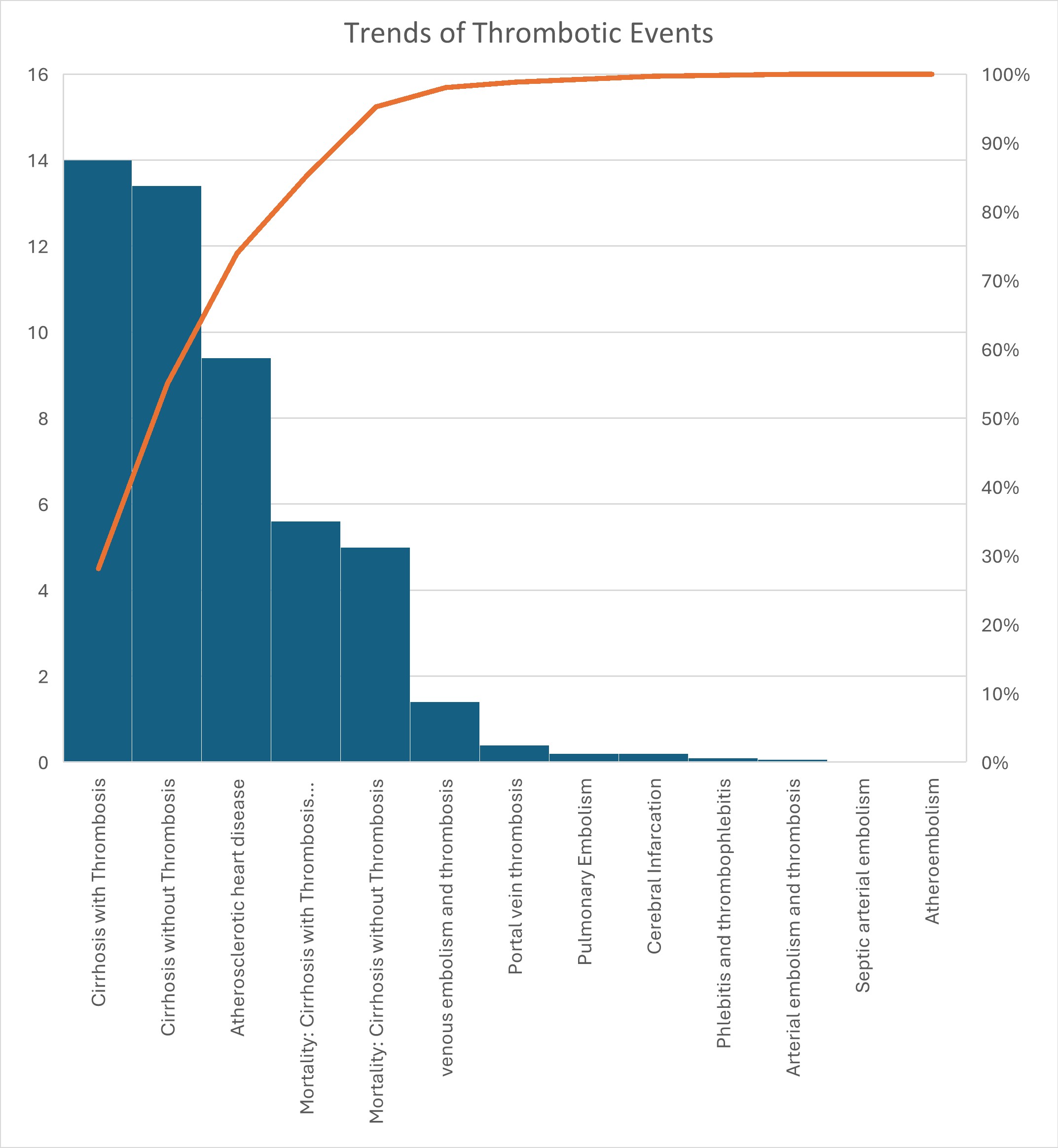Monday Poster Session
Category: Liver
P3802 - Cirrhosis Meets Clotting: A 6-Year Retrospective Study (2016-2021)
Monday, October 27, 2025
10:30 AM - 4:00 PM PDT
Location: Exhibit Hall

Silpa Choday, MD (she/her/hers)
Creighton University School of Medicine
Phoenix, AZ
Presenting Author(s)
Silpa Choday, MD1, Tamer Zahdeh, MD2, Dinuka Bandara, DO3, Dushyant S. Dahiya, MD4, Hassam Ali, MD5, Sheza Malik, MD6, Dalbir S. Sandhu, MD7, Wael Youssef, MD1
1Creighton University School of Medicine, Phoenix, AZ; 2Montefiore Medical Center, New York, NY; 3Creighton University School of Medicine, Scottsdale, AZ; 4University of Kansas School of Medicine, Kansas City, KS; 5East Carolina University/Brody School of Medicine, Greenville, NC; 6Emory University, Atlanta, GA; 7St. Joseph's Hospital and Medical Center, Phoenix, AZ
Introduction: Cirrhosis is a chronic liver condition associated with significant morbidity and mortality, often complicated by thrombotic events. Thrombosis in cirrhosis presents a significant challenge due to the coexistence of bleeding risks and hypercoagulability. This study examines the prevalence, demographic characteristics, trends, and clinical outcomes of thrombosis among patients with cirrhosis over a six-year period.
Methods: This retrospective cohort study analyzed patients admitted with cirrhosis and thrombosis. Data was acquired from the Nationwide Inpatient Sample from 2016 to 2021. Total hospital costs were calculated using HCUP Cost-to-Charge Ratio files and adjusted for inflation based on the Consumer Price Index (CPI) with 2021 as the reference year.
Results: During the 6-year period 2016-2021, a total of 537,650 patients with cirrhosis were identified, of whom 89,220 were diagnosed with thrombosis (p=0.04). Individuals with cirrhosis and thrombosis were older compared to those without thrombosis (mean age: 63 years vs. 55 years, p< 0.001). There was a male predominance among patients with thrombosis (70% vs. 30%). The White population had the highest prevalence, followed by Hispanics and Blacks (p=0.8).
Among thrombosis types, an increasing trend was observed in thrombophlebitis (p=0.003), arterial embolism and thrombosis (p=0.1), venous embolism and thrombosis which includes deep vein thrombosis (p< 0.001), atherosclerotic heart disease (p=0.02), and portal vein thrombosis (p=0.02). A steady trend was noted for pulmonary embolism (p< 0.001), while no significant changes were observed for septic arterial embolism (p=0.3), athero-embolism (p=0.9), or phlebitis (p=0.2).
Thrombosis was associated with an increased mortality rate (6% vs. 5%, p< 0.001), longer hospital stays (mean: 7.2 vs. 6 days), and higher hospital costs ($108,347 vs. $79,230). Comorbidities were more common among patients with thrombosis and included coagulopathy (52%), anemia (39%), alcohol use (38%), hypertension (35%), heart failure (24%), obesity (17%), and diabetes (16%) (all p< 0.001).
Discussion: Thrombosis is a significant complication in patients with cirrhosis, particularly among older males and the White population. Its presence is associated with increased mortality, longer hospital stays, and higher healthcare costs. Trends indicate rising rates of venous thrombosis, portal vein thrombosis, and other thrombotic conditions, with notable comorbidities contributing to the disease burden.

Figure: Table1: Trends of hospitalization of various thrombotic events

Figure: Figure 1: Trends of thrombotic events
Disclosures:
Silpa Choday indicated no relevant financial relationships.
Tamer Zahdeh indicated no relevant financial relationships.
Dinuka Bandara indicated no relevant financial relationships.
Dushyant Dahiya indicated no relevant financial relationships.
Hassam Ali indicated no relevant financial relationships.
Sheza Malik indicated no relevant financial relationships.
Dalbir Sandhu indicated no relevant financial relationships.
Wael Youssef indicated no relevant financial relationships.
Silpa Choday, MD1, Tamer Zahdeh, MD2, Dinuka Bandara, DO3, Dushyant S. Dahiya, MD4, Hassam Ali, MD5, Sheza Malik, MD6, Dalbir S. Sandhu, MD7, Wael Youssef, MD1. P3802 - Cirrhosis Meets Clotting: A 6-Year Retrospective Study (2016-2021), ACG 2025 Annual Scientific Meeting Abstracts. Phoenix, AZ: American College of Gastroenterology.
1Creighton University School of Medicine, Phoenix, AZ; 2Montefiore Medical Center, New York, NY; 3Creighton University School of Medicine, Scottsdale, AZ; 4University of Kansas School of Medicine, Kansas City, KS; 5East Carolina University/Brody School of Medicine, Greenville, NC; 6Emory University, Atlanta, GA; 7St. Joseph's Hospital and Medical Center, Phoenix, AZ
Introduction: Cirrhosis is a chronic liver condition associated with significant morbidity and mortality, often complicated by thrombotic events. Thrombosis in cirrhosis presents a significant challenge due to the coexistence of bleeding risks and hypercoagulability. This study examines the prevalence, demographic characteristics, trends, and clinical outcomes of thrombosis among patients with cirrhosis over a six-year period.
Methods: This retrospective cohort study analyzed patients admitted with cirrhosis and thrombosis. Data was acquired from the Nationwide Inpatient Sample from 2016 to 2021. Total hospital costs were calculated using HCUP Cost-to-Charge Ratio files and adjusted for inflation based on the Consumer Price Index (CPI) with 2021 as the reference year.
Results: During the 6-year period 2016-2021, a total of 537,650 patients with cirrhosis were identified, of whom 89,220 were diagnosed with thrombosis (p=0.04). Individuals with cirrhosis and thrombosis were older compared to those without thrombosis (mean age: 63 years vs. 55 years, p< 0.001). There was a male predominance among patients with thrombosis (70% vs. 30%). The White population had the highest prevalence, followed by Hispanics and Blacks (p=0.8).
Among thrombosis types, an increasing trend was observed in thrombophlebitis (p=0.003), arterial embolism and thrombosis (p=0.1), venous embolism and thrombosis which includes deep vein thrombosis (p< 0.001), atherosclerotic heart disease (p=0.02), and portal vein thrombosis (p=0.02). A steady trend was noted for pulmonary embolism (p< 0.001), while no significant changes were observed for septic arterial embolism (p=0.3), athero-embolism (p=0.9), or phlebitis (p=0.2).
Thrombosis was associated with an increased mortality rate (6% vs. 5%, p< 0.001), longer hospital stays (mean: 7.2 vs. 6 days), and higher hospital costs ($108,347 vs. $79,230). Comorbidities were more common among patients with thrombosis and included coagulopathy (52%), anemia (39%), alcohol use (38%), hypertension (35%), heart failure (24%), obesity (17%), and diabetes (16%) (all p< 0.001).
Discussion: Thrombosis is a significant complication in patients with cirrhosis, particularly among older males and the White population. Its presence is associated with increased mortality, longer hospital stays, and higher healthcare costs. Trends indicate rising rates of venous thrombosis, portal vein thrombosis, and other thrombotic conditions, with notable comorbidities contributing to the disease burden.

Figure: Table1: Trends of hospitalization of various thrombotic events

Figure: Figure 1: Trends of thrombotic events
Disclosures:
Silpa Choday indicated no relevant financial relationships.
Tamer Zahdeh indicated no relevant financial relationships.
Dinuka Bandara indicated no relevant financial relationships.
Dushyant Dahiya indicated no relevant financial relationships.
Hassam Ali indicated no relevant financial relationships.
Sheza Malik indicated no relevant financial relationships.
Dalbir Sandhu indicated no relevant financial relationships.
Wael Youssef indicated no relevant financial relationships.
Silpa Choday, MD1, Tamer Zahdeh, MD2, Dinuka Bandara, DO3, Dushyant S. Dahiya, MD4, Hassam Ali, MD5, Sheza Malik, MD6, Dalbir S. Sandhu, MD7, Wael Youssef, MD1. P3802 - Cirrhosis Meets Clotting: A 6-Year Retrospective Study (2016-2021), ACG 2025 Annual Scientific Meeting Abstracts. Phoenix, AZ: American College of Gastroenterology.
